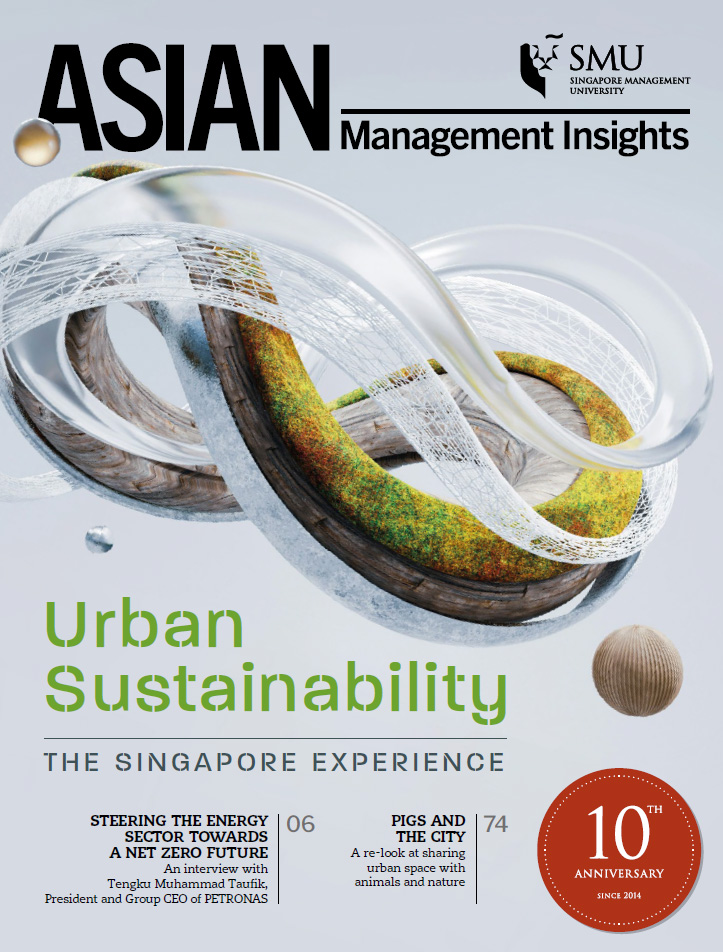More than half of humanity currently lives in urban areas, and the United Nations predicts that figure will reach 70 percent by 2050. Cities worldwide already generate a significant amount of solid waste annually, adding to vexing issues that the global community is trying to address–demand for transportation, air pollution, access to public open spaces, urban sprawl, and general sustainability challenges. Throw in global warming and the copious greenhouse gas (GHG) emissions borne of construction activities, and the challenge of creating the necessary urban infrastructure to cope comes into sharp focus.
Lee Chuan Seng, Chairman of Singapore’s National Environment Agency, led the development of the internationally-recognised BCA (Building and Construction Authority) Green Mark certification for a building’s environmental impact and performance. In this issue of Asian Management Insights (AMI), Lee, also the founding President of the Singapore Green Building Council, shares his insights on the country’s goal of greening 80 percent of total gross floor area, achieving a 99-percent recycling rate for construction demolition debris, and developing policy thinking regarding sustainability.
Decarbonisation will be a crucial element in addressing some of those issues, which Tengku Muhammad Taufik has thought long and hard about. The President and Group CEO of PETRONAS expounds on how the Malaysian multinational oil and gas company plans to achieve Net Zero carbon emissions by 2050 by utilising cutting-edge technology and Artificial Intelligence to pave its path forward.
Electric cars or carbon-neutral synthetic fuels? Both help reduce GHG output from the road transport sector, which accounts for 75 percent of global transport emissions. Mark Stevenson and Terry van Gevelt present different solutions. Stevenson proposes promoting electric vehicles (EVs) and micro- mobility, and, just as important, tracking emissions from cars and incentivising driving behaviour that reduces the emissions. In turn, van Gevelt points to the environmental impact of building EV charging infrastructure, and highlights the technological breakthroughs of synthetic e-fuels and their potential to deliver a less disruptive transition to a low-carbon future.
Tree-planting and preservation of nature reserves are another way of greening the urban environment, but wildlife can flourish therein and venture out into human-populated areas. Sayd Randle recounts the Singapore experience of managing the coexistence of wild boars and otters with humankind, and how cities such as Houston and Hong Kong balance urban development with ecological sustainability.
Greening initiatives and the cutting of carbon emissions would help cities manage what Loretta Lees calls the ‘triple-H’ of Housing, Heat, and Health. Rising temperatures and increasingly unaffordable housing create physical and mental health issues, which necessitate socially and environmentally just policies to address the needs of the vulnerable and marginalised.
All that will be of great interest to cities in Southeast Asia, where massive traffic jams are a longstanding, and seemingly intractable, problem. But as Shoeb Kagda explains, the recently operational high-speed train between Jakarta and Bandung has sparked a glimmer of hope. While the region’s tropical weather cannot be fundamentally changed, Southeast Asia’s mega metropolises are set to invest heavily in urban transit systems to solve their gridlock woes.
How do you fit ESG metrics into executive compensation? In Asia, there is still a relative lack of attention paid to the (E)nvironmental factors, and how achievements on the (S)ocial part are often measured, and therefore rewarded, in the short-term. Shai Ganu, Managing Director and Global Leader of the Executive Compensation and Board Advisory business at WTW, explains how companies can design executive compensation to drive climate change objectives and align moral imperatives with business priorities, so as to enable corporate (G)overnance to play its part.
Over in India, a ‘perfect storm’ comprising heavyweight telecom firms, digital technology innovation, payment systems evolution, and widespread smartphone adoption has changed the digital landscape. Rajendra Srivastava, Vijay Shankar S, and Aman Rajeev Kulkarni recount how India got to where it is now in its digital evolution, as well as the opportunities and challenges that lay ahead as Asia’s third largest economy shifts from cost minimisation to technology development.
And in this issue’s Case In Point, Geng Xuesong, Andrew Chin, and Thomas Lim tell the story of how the Singaporean multi-dining concept chain JUMBO Group tried, failed, and finally succeeded in digitalising what has largely been a pen-and-paper business. The benefits–better cost control, responsive customer service, and accurate decision-making–are worth all the trouble.
And finally, as part of our continual editorial review, we are excited to introduce Insights as the new umbrella section that covers the erstwhile Industry Watch and Executive Brief sections. We believe Insights would better characterise the thematic content we will be bringing to our readers. Happy reading!
